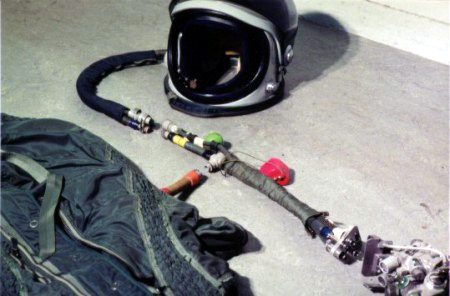History
In the second half of the sixties there was a serious threat from highflying Soviet
bombers and reconnaissance planes. To intercept them, the pilots had to boldly go were no
man has gone before (!). The Netherlands was flying the F-104G Starfighter in those days.
The Starfighter turned out to be very useful in the hit and run tactics. Because of the
high altitude the planes had to fly, special gear was needed.

Tactics
An intercept would start at 35,000 feet, throttle in full afterburner and at almost mach 2
the nose was raised 45 degrees. The shape of this pattern was parabolic. At the top you
had to encounter the potential enemy and fire one rocket. Over that point you were on your
way down again. For practice intercepts, the RAF Canberra's were used, as they were able
to operate up to 65,000 feet. The Dutch record for these flights was an altitude of 79,900
feet, reached by Col. Van Leeuwen. Pilots chosen to do these intercepts had tailor made
pressure suits with pressure helmets. In use were the French EFA-ARZ-30 pressure suit and
the EFA Type 21/23 helmet. A total of approx. 35 was ordered. The price in those days for
a Type 21/23 helmet was 3500 guilders (At the current rate this would be approx. $7000).

The Gear
Combinasion Stratosphérique EFA - ARZ Type 30
The suit is made of a green nylon mixture to allow great elasticity. A rubber like bladder
forms the inflatable part of the suit. The bladder is attached inside the suit with snap
fasteners. This bladder covers the chest, abdomen, back and the outer sides of the arms
and legs. For inflation, a small hose under the right arm is present. To make a tight fit,
the suit has a lace adjustment system. In some airforces, the pressurised gloves were also
used. Small tubes on the end of the sleeves can be connected to these gloves. When the
gloves were not used, or used without inflating them (Netherlands Airforce), the tubes had
to be sealed off.

Le sous-vêtement ventilé EFA Type 25
Under the suit, the EFA type 25, cotton ventilation suit is worn with a small hose on the
belly. This is giving the pilot the needed fresh air under his suit.

Ensemble de Tête EFA Type 21 and 23
The helmets used are the Type 21 and 23. The only noticable difference between the two is
the name on the label in the neckring. The helmet shell used, had a thickness of 2.2 mm
with reinforced parts of 3 mm at the visors attachment points. The visor consisted of
Plexiglas layers with a small space in between that contained a 24 volts heating device. A
tinted visor for solar protection was also installed. The helmet could be strapped
internally with the aid of a large knob on the back of the head. This knob tightens or
loosens the internal helmet parts like the ear cups with small cables. For communications,
a boom microphone and speakers are installed inside the shell. The helmet also features an
oxygen hose and valves that keep the pressure in the helmet at the desired level. The
helmet has a ventilation and respiration task. For attaching and sealing the helmet is
attached to the suit with a neck ring. This ring features a rubber collar that keeps the
air inside the helmet. The ARZ-30 suit has a large strap that goes from the back between
the legs to the front side of the suit. The strap is attached to the neck ring and is
tightened to keep the helmet in place.
Helmet modifications
The Dutch EFA Type 21/23 has been modified at least one time. As pictures are compared it
is clear that at a certain point in service life, the helmet got a new oxygen hose
assembly. According to their service cards, the helmets were send to EFA for modification
to the leads in 1971.

The presumed early example had the oxygen hose and communications cord in a round housing
entering the helmet. (As seen in the pictures). In this version, the boom microphone was
positioned on the right side of the helmet. (Were the oxygen hose and cord's are entering
the helmet) The presumed later version had a newly designed oxygen hose assembly. The
oxygen entered the helmet through a metal tube and the housing changed shape as well. This
also meant reposition of the boom microphone and communications cord that moved to the
left side. (As seen in the close-up)

Checklist
Besides the usual checks, the EFA equipped pilots had to perform several other checks
before and after flying. According to studies, an average of 1 flight per month for each
pilot was sufficient.

Collections
In the Netherlands only a few complete sets exist. Two are shown in the Military Aviation
Museum near Soesterberg Airbase, but they have aprox 5 helmets and 8 suits in total.
Another one can be found at Leeuwarden Airbase and there are at least four sets in private
hands. Sometimes a single helmet surfaces mostly with out neck ring. Dutch helmets were
all marked with reflective tape on the back side in an inverted T shaped pattern.

Special thanks to Daniel Djebrani for his info. Most
pictures are from official Netherlands Airforce instruction slides.
|